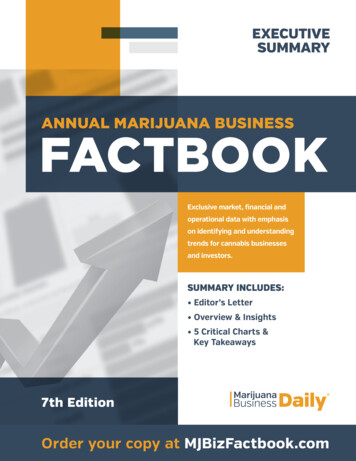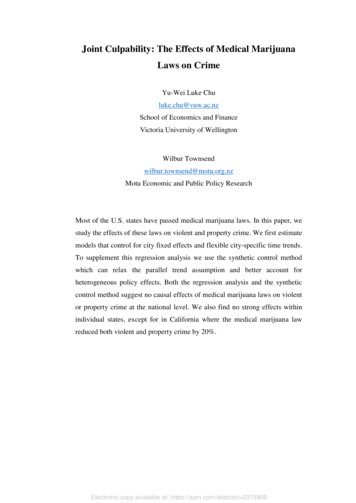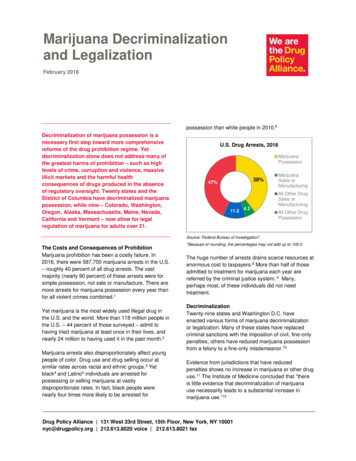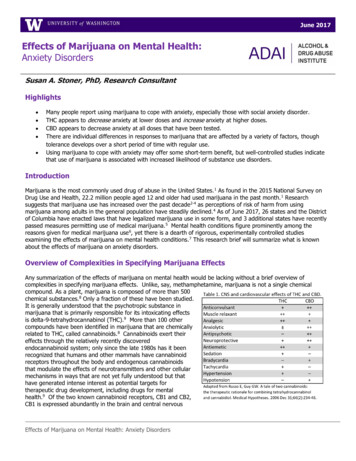
Transcription
MarijuanaBusiness Daily COMPLlMENTARYEXCERPTMarijuanaBusinessFactbook 2017Exclusive Financial DataFor Cannabusinesses& Major lnvestorsExcerpt lncludes: Editor’s Letter Overview & Top Takeaways Executive Summary:12 Key Charts & Findings Complete Table of ContentsTo order your copy today, go to: MJBizFactbook.com
Executive SummaryFrom the EditorWelcome to the fifth edition of the Marijuana Business Factbook, produced by theresearch and editorial team at Marijuana Business Daily.Inside this report, you’ll find a host of business and financial information that can beused to start a cannabis business, grow or improve an existing one, land financing, makeinvestments in cannabis companies, identify opportunities and understand the competitivesituation as well as the industry at large.There’s a reason many professionals in the industry refer to this as the “Marijuana bible”– it’s an invaluable resource for anyone involved in the business of cannabis or hoping toget involved.Once again, we have expanded and strengthened the scope of our research andimproved the quality of our data. That means all figures, charts, projections and analysiscontained in these pages are new. We’ve also changed methodologies in some key areasto provide a more nuanced and accurate view of this industry.Some of the enhanced information included in this edition: Further breakdowns of operational and financial information that reflect differingbusiness models. Some examples include: Data on companies operating in markets without statewide regulations versustheir peers in regulated states. Differences in metrics for infused product companies that also grow their owncannabis versus those that do not. “Real World Examples” that dive a little deeper into a dataset by highlightingeverything from a specific company’s startup costs to actual sales for the topcannabis retailers in Washington state to the percentage of markets that allowwholesale cultivation. Copyright 2017, Marijuana Business Daily, a division of Anne Holland Ventures Inc. You may NOT copy this Factbook, or make public the data and factscontained herein, in part or in whole. For more copies or editorial permissions, contact CustomerService@MJBizDaily.com or call (401) 354-7555 x1.
Page 2Marijuana Business Factbook 2017: Executive Summary Enhanced third-party data on retail and wholesale cannabis pricing trends, whichcan be found at the end of chapters 3 and 4. New types of data, such as the soil medium growers use, the types of paymentsretailers accept and how much companies pay each month for banking services. Estimated job growth over the past year and going forward through 2021. We alsorevised our methodology for estimating the number of jobs in the industry basedon new information, providing a more accurate view of employment. An overview of the potential market size 3-5 years down the road in states thatlegalized in 2016, including the recreational marijuana industries in California,Maine, Massachusetts and Nevada as well as the medical industries in Arkansas,Florida (which expanded its CBD-focused program by legalizing a broader, fullstrength MMJ program), Louisiana (which paved the way for a regulated industry),North Dakota, Ohio and Pennsylvania. This information can be found at the end ofChapter 2.And of course, we have included all the information readers have come to rely on, suchas profitability and revenue metrics for businesses in each major sector of the industry,retail sales projections nationally and by state, economic impact estimates.This year our data analyst Eli McVey spearheaded the Factbook. His experience workingboth within the industry and outside of it, notably at the prestigious research firm Nielsen,helped us take this report to the next level. The rest of the Marijuana Business Dailyeditorial team also contributed, including reporters John Schroyer, Bart Schaneman andOmar Sacirbey as well as our senior editors Roger Fillion and Kevin Huhn.It’s important to note that we are somewhat conservative with our estimates andprojections, both for the existing industry and its potential growth going forward. Westrive to provide realistic numbers, not make the industry appear bigger than it really is.We don’t lobby, offer investments, provide consulting services or have any other reason topublish hype.As a result, our estimates for national and state-level retail marijuana revenues are oftenlower than many other projections out there. We believe a conservative approach will helpyou make sound business decisions, and we have a solid track record with our estimatesdespite the huge amount of uncertainty and lack of reliable data in general. Most of theestimates we’ve made in the past turn out to be spot-on. If we need to revise numbers, itoften involves revising them upward – not downward.A couple of quick notes on using this Factbook: If you’re interested in overarching national data, start with Chapter 1 for a look atretail sales estimates for the U.S. marijuana industry, economic impact projections,employment figures and a look at overarching financial data for the major niches. Copyright 2017, Marijuana Business Daily, a division of Anne Holland Ventures Inc. You may distribute copies of this Executive Summary as PDFs or inprint BUT ONLY if they are reproduced in their entirety! For permissions or service, contact CustomerService@MJBizDaily.com or call (401) 354-7555 x1.
ORDER YOUR COPY AT MJBizFactbook.comPage 3 If you want an overview of each state’s market – including estimated sales,approved medical conditions, whether home grows are allowed and stability/opportunity rankings – head to Chapter 2. If you’re seeking financial and operational benchmark data such as startup costs,profitability metrics and average revenue for retailers, dive into Chapter 3. If you’re looking for financial and operational benchmark data for cultivators, headto Chapter 4. If you are interested in financial and operational benchmark data for infusedproduct companies, flip to Chapter 5. If you want an overview of financial and operational data for testing labs andancillary companies, check out Chapter 6. If you’re an investor in the industry or are seeking financing data, go to Chapter7 for information on everything from how much companies are hoping to raise tosources of capital MJ businesses have used to launch and typical investor returns. For a rundown of our methodology, read the Appendix at the end of this report.If you have any suggestions or want to provide feedback, please contact me atchrisw@mjbizdaily.com or reach out to our data analyst Eli McVey at elim@mjbizdaily.com.Best of luck with your cannabusiness endeavors,Chris WalshEditorial DirectorNote: Want to publish or use our charts and numbers somewhere else? The charts andtables in this Executive Summary are yours to use with proper attribution, as long asyou don’t alter them in any way. Copyright 2017, Marijuana Business Daily, a division of Anne Holland Ventures Inc. You may distribute copies of this Executive Summary as PDFs or inprint BUT ONLY if they are reproduced in their entirety! For permissions or service, contact CustomerService@MJBizDaily.com or call (401) 354-7555 x1.
Page 4Marijuana Business Factbook 2017: Executive SummaryOverview & Key TakeawaysThe number of technology companies serving the marijuana industry has grownsubstantially in recent years, providing insights into everything from retail sales towholesale cannabis pricing and consumer purchasing patterns. Just a few short years ago,entrepreneurs, executives and investors had almost no hard information by which to makedecisions and instead had to rely largely on gut feelings.But there’s still a substantial lack of even basic financial and operational informationabout the companies in this space and the industry at large.There are several reasons for this: The federal government doesn’t track the industry, so information on jobs, thenumber of companies in the space and taxes paid simply isn’t available across theindustry as a whole. Each state approaches its cannabis industry differently. A handful provide solidin-depth data, such as tax revenue generated from the industry, the names of alllicensed companies and monthly or annual retail sales. But most states do not.Some don’t even keep track of how many patients participate in their programs. The industry still doesn’t have a solid presence on the public markets.Entrepreneurs can typically glean useful information by examining the filings andfinancial statements of publicly traded companies. However, the vast majority ofcannabis companies are privately held, while most publicly traded marijuana firmsare listed on the over-the-counter markets, where the reporting and disclosurerequirements are light. While some insights can be gained from documents filed bypublicly traded cannabis companies, these reports are generally unaudited and onlyrepresent a sliver of the marketplace. Tax returns for nonprofit organizations are in the public domain, and many medicaldispensaries must operate in a not-for-profit manner. However, their status assuch is not formally recognized by the IRS, and therefore their tax returns are notpublicly available.As a result, business owners and investors don’t have the types of financial information,benchmark data and in-depth market insight necessary to help them make decisions,assess the competition, target investments and tackle new opportunities. This reporthelps to fill that void by providing exclusive data and insight into these areas, relying oninformation gleaned from our annual survey of cannabis professionals, our third-partydata partners, our institutional knowledge and expertise, and interviews with marijuanaexecutives and experts (refer to the methodology section of the Appendix for details). Copyright 2017, Marijuana Business Daily, a division of Anne Holland Ventures Inc. You may distribute copies of this Executive Summary as PDFs or inprint BUT ONLY if they are reproduced in their entirety! For permissions or service, contact CustomerService@MJBizDaily.com or call (401) 354-7555 x1.
ORDER YOUR COPY AT MJBizFactbook.comPage 5The lion’s share of financial and operational data in this report stems from our annualonline survey of cannabis professionals. This year’s Factbook includes the responses ofmore than 800 business owners, executives, entrepreneurs and investors. Their inputhelped give us a window into operational data for the main sectors of the industry: retail,cultivation, infused products, testing, ancillary technology/products and ancillary services.Additionally, survey responses are behind most of the data in an entire chapter on fundingand investing.We also utilize data-sharing partnerships with reputable firms in the industry, allowingus to provide an in-depth look at two major areas: point-of-sale transactions andwholesale cannabis pricing. Marijuana Business Daily would like to extend special gratitudeto the following data partners for their contributions to this book: Headset, which provides business intelligence and analytics services for marijuanabusinesses. Cannabis Benchmarks, a division of New Leaf Data Services LLC, which trackswholesale medical and recreational cannabis prices across the United States.Data from these partners is featured in chapters 3 and 4, and more information on eachof these companies can be found in the Appendix.Additionally, Marijuana Business Daily would like to thank the following individuals andorganizations for their support in spreading the word about this year’s survey of cannabisprofessionals and providing valuable market expertise:Apeks Supercritical, Canna Advisors, Cannabis Business Alliance, Charles Bachtellof Cresco Labs, Custom Vault, DB3, Denver Relief Consulting, Dixie Brands,Green Rush Consulting, Guardian Data Systems, Headset, Kristi Knoblich of KivaConfections, Noah Novello of LivWell, Medicine Man Technologies, MJardin,Quantum 9, Sapphire Risk Advisory Group, SIVA Enterprises. Copyright 2017, Marijuana Business Daily, a division of Anne Holland Ventures Inc. You may distribute copies of this Executive Summary as PDFs or inprint BUT ONLY if they are reproduced in their entirety! For permissions or service, contact CustomerService@MJBizDaily.com or call (401) 354-7555 x1.
Page 6Marijuana Business Factbook 2017: Executive Summary5 Key TakeawaysThis report is meant to serve as a detailed point of reference with specific data pointsand figures. However, there are larger trends and themes that emerge after sifting throughthe full data set of survey responses and performing the research for this book. Below is anoverview of these key takeaways:1Businesses are increasingly concerned about the possibility of federalinterventionThe commercial marijuana industry exists on a state-by-state basis, and all medicaland recreational programs are technically in violation of federal drug laws. The U.S.Department of Justice issued some guidelines in recent years that helped the marijuanaindustry gain traction, but these are not legally binding and could theoretically be nullifiedat any time.So it’s easy to understand why cannabis businesses are worried about the future undera new administration. President Trump’s pick to head the Department of Justice, JeffSessions, has made his disdain for marijuana abundantly clear. Furthermore, the Trumpadministration’s first public comment on the nation’s marijuana industry seemed tosuggest greater enforcement of federal marijuana laws are forthcoming, though in whatshape or form is anybody’s guess.In our 2016 survey of cannabis professionals, the threat of federal intervention ranked asthe third-most prevalent challenge facing marijuana business owners. This year, it took thetop spot – reflecting the cloud of uncertainty hovering over the marijuana industry. Thatuncertainty could affect everything from expansion plans to investments to overall growthin 2017 and beyond.2Investment deals are increasing in size, frequency and scopeInvestors – especially those unfamiliar with the cannabis market – have traditionallybeen hesitant to invest in an industry the federal government still views as illegal. Whilethis still holds true for major institutional investors, smaller firms and groups of wealthyindividuals are becoming increasingly interested in the cannabis space. In 2016, forinstance, the private equity firm Tuatara Capital raised 93 million for investments incannabis businesses, a record for the marijuana industry.Our survey found that investors who have already pumped money into the cannabisindustry are planning on putting capital into nearly as many marijuana businesses in 2017as they have in all previous years combined – a revealing statistic that shows just howoptimistic investors are for the future of the marijuana industry. Copyright 2017, Marijuana Business Daily, a division of Anne Holland Ventures Inc. You may distribute copies of this Executive Summary as PDFs or inprint BUT ONLY if they are reproduced in their entirety! For permissions or service, contact CustomerService@MJBizDaily.com or call (401) 354-7555 x1.
ORDER YOUR COPY AT MJBizFactbook.com3Page 7Business conditions are worsening for growersThough it’s still early days for the cannabis industry overall, the wholesale cultivationsegment has already become saturated in large, mature markets like Colorado andWashington state. More growers entered the industry upon recreational legalization, andexisting MMJ cultivators greatly expanded their operations. Despite rising adult-use sales,the increase in production proved even greater than demand – sending wholesale cannabisprices plummeting. Some cultivators that shelled out for expensive indoor facilities arefinding that costs of production now exceed the market price per pound of cannabis.More than any other segment of the industry, wholesale cultivators that took our surveyanticipate their financial conditions will worsen over the next 12 months. Investors appearto have taken notice as well, signaling their intentions to reign in investment activity withinthis segment of the industry.4Rec market continues surgingAs the first state in the nation to legalize recreational marijuana, Colorado’s adult-usemarket got off to an extremely strong start – routinely posting monthly sales gains in thedouble digits. Washington state’s recreational market also boomed once it got over someinitial hurdles after launching in 2014.But many expected that, over time, sales would begin to slow, especially as more stateslegalized rec cannabis and the novelty wore off.So far, however, sales have only continued to rise. In Washington state and Colorado,rec customers spent over 1.5 billion on marijuana in 2016, ballooning a combined 66%from the previous year. Rec sales tripled in Oregon from February to August 2016, thoughthey were hurt by the implementation of strict new testing standards. The sales figures areespecially striking because they come amid a time of historically low wholesale marijuanaprices, implying that demand is even stronger than sales would suggest. Additionally,Oregon and Washington are neighbors, and the fact that both have functioningrecreational marijuana industries hasn’t led to any slowdown in sales in either market.While it remains to be seen how rec markets in 2017 will ultimately fare, early figures outof Colorado and Washington state show sales are at levels way above this same time lastyear – illustrating the growth potential these relatively mature markets still possess.5It’s taking companies longer to turn a profitJust a couple of years ago, running a profitable marijuana company was simply amatter of getting the business off the ground and opening your doors. But the industry Copyright 2017, Marijuana Business Daily, a division of Anne Holland Ventures Inc. You may distribute copies of this Executive Summary as PDFs or inprint BUT ONLY if they are reproduced in their entirety! For permissions or service, contact CustomerService@MJBizDaily.com or call (401) 354-7555 x1.
Page 8Marijuana Business Factbook 2017: Executive Summaryhas evolved at a rapid pace, and a huge number of new businesses entering the cannabisspace has raised the level of competition considerably. In major recreational markets likeSeattle, Denver and Portland, consumers have access to numerous retail stores and anoverwhelming amount of product options.At the same time, startup costs are rising rapidly. It now can cost hundreds of thousandsof dollars, or even millions, to launch a plant-touching company, while just a few years agoit cost half that or less in many markets.Naturally, therefore, it’s taking companies longer to climb into the black. In early 2016,nearly 70% of retailers, wholesale cultivators and infused product manufacturers said theyhad reached break-even or profitability within a year. In our 2017 survey, about 55% ofthese businesses said they reached the break-even point or hit profitability within a year.Profitability is by no means unattainable for cannabis businesses; generally speaking,most of these companies are doing quite well. But market forces are unavoidable, andthey’ll continue forcing marijuana businesses to adapt and improve in order to succeed. Copyright 2017, Marijuana Business Daily, a division of Anne Holland Ventures Inc. You may distribute copies of this Executive Summary as PDFs or inprint BUT ONLY if they are reproduced in their entirety! For permissions or service, contact CustomerService@MJBizDaily.com or call (401) 354-7555 x1.
ORDER YOUR COPY AT MJBizFactbook.comPage 9Who’s Behind This Factbook?InclusivenessIntegrityConnecting theentirety of thecannabis community isthe foundation of theindustry’s success.Unbiased informationwithout paid influencedelivers the highestvalue to allparticipants.ResponsivenessServing the industry’srapidly changing needsrequires listening andadapting.Our 5CoreValuesProfessionalismMainstreamacceptance hinges onelevating theindustry’s businesspractices.QualitySound businessdecisions are driven byreliable news, data andinsights.Founded in early 2011, MarijuanaBusiness Daily focuses solely oncannabis businesses and theinvestors who back them.If you are leading or financing acannabis-related company, we helpyou prosper via trusted informationservices and exceptional events.Our publications have the highestbusiness readership in the industry.Our events are sellouts, time aftertime. We’ve been featured everywherefrom Harvard Business Review toForbes, Fortune, Fast Company andInc. Magazine.Do you need practical information,real-life data or industry connectionsto help your business grow? You’llfind what you need in one of ourpublications, or at our nationalevents.We are here to help the multibilliondollar cannabis industry prosper. Letus know how we can serve you.A division of Anne Holland Ventures Inc.Marijuana Business Daily Headquarters 2750 S. Wadsworth Blvd. Suite D200, Denver, CO 80227CustomerService@MJBizDaily.com Phone: 401.354.7555 x1Twitter: @MJBizDaily www.MJBizDaily.com Copyright 2017, Marijuana Business Daily, a division of Anne Holland Ventures Inc. You may distribute copies of this Executive Summary as PDFs or inprint BUT ONLY if they are reproduced in their entirety! For permissions or service, contact CustomerService@MJBizDaily.com or call (401) 354-7555 x1.
Marijuana Business Factbook 2017: Executive SummaryPage 10Executive Summary: 12 Key ChartsThe marijuana floodgates are bursting wide open.In 2017, we expect overall marijuana sales in the United States at the retail level to soarby roughly 30%, hitting 5.1 billion- 6.1 billion on the back of continued growth in existingrecreational cannabis markets. In fact, rec sales are expected to surpass medical this yearfor the first time ever. Medical marijuana sales also are expected to buoy the industry,fueled in part by the expected launch of MMJ markets in Maryland and Hawaii. At the sametime, fledging medical marijuana programs in states such as Illinois, Nevada and New Yorkcould post impressive growth this year.U.S. Cannabis Retail Sales Estimates: 2016 - 2021(In Billions Of U.S. Dollars) 16B 14BRecreationalMedical 11.9- 17.1 Total 10.1- 13.7 TotalTotal Retail Sales 12B 8.5- 11.6 Total 10B 6.7- 8.8 Total 8B 5.1- 6.1 Total 6B 4.0- 4.5 Total 4B 2B 0B 7.1- 10.3 6.4- 8.6 5.4- 7.3 3.8- 5.0 2.6- 2.9 1.8 2.2- 2.7 2.5- 3.220162017 2.9- 3.8 3.1- 4.320182019 3.7- 5.1 4.8- 6.820202021Copyright 2017 Marijuana Business Daily, a division of Anne Holland Ventures Inc. All rights reserved.The expected growth this year comes after a solid 2016, when recreational cannabis salesjumped by 80% to hit 1.8 billion. Colorado and Washington led the charge, while Oregon’sadult-use market posted strong sales gains in its first full calendar year of operation. Theindustry also saw a spike in medical marijuana sales last year, as patient counts rose in newMMJ states and continued climbing in mature markets like Arizona and Michigan.The 2017 Marijuana Business Factbook provides an in-depth look at the immense yearover-year growth the industry has experienced and offers exclusive projections on whereit’s headed. Be sure to check out Chapter 2 for an overview of every medical and rec state,including estimated sales, business stability and opportunity rankings, and how eachmarket fits into the big picture.Although this year is shaping up to be another one for the record books, the longerterm growth potential for the industry is even more promising. Copyright 2017, Marijuana Business Daily, a division of Anne Holland Ventures Inc. You may distribute copies of this Executive Summary as PDFs or inprint BUT ONLY if they are reproduced in their entirety! For permissions or service, contact CustomerService@MJBizDaily.com or call (401) 354-7555 x1.
ORDER YOUR COPY AT MJBizFactbook.comPage 11The majority of the 11 states that legalized medical or recreational marijuana in 2016(or passed laws that will create state-regulated industries) are aiming to start sales in2018, including the potentially massive adult-use markets in California and Massachuetts.Nevada, which will allow an early start to adult-use sales starting in July 2017, will alsostart hitting its stride on the rec front next year. Delays in program rollouts – a commonoccurrence in new markets – could push some of this growth into 2019, but sales shouldstill increase sizably next year.These new markets, as well as other states that legalize in the near future, will set thestage for impressive growth over the next five years. By 2021, we project that annual retailmarijuana sales in the United States could top 17 billion, which would represent a 300%increase from 2016.Of course, there’s a big caveat: The election of Donald Trump as U.S. president has cast acloud of uncertainty over the industry. Recent statements by some White House officials –including Attorney General Jeff Sessions – have marijuana business owners concerned. Thoughit remains unclear as to how the Trump adminsitration will ultimately approach the industry,increased enforcement of federal regulations could have a significant impact on future sales.Note that our goal is to provide conservative, realistic financial forecasts that reflectthe high degree of uncertainty in the industry. Total cannabis sales in any given calendaryear are highly dependent upon progress made – or not made – in each individual state.California is the big wild card at present, as the lack of a statewide regulatory systemmakes it difficult to get a handle on the exact size of this enormous market. As moreinformation comes to light over time, it could change our estimates for California and,therefore, the industry at large.The increase in retail sales over the next five years will provide a substantial economicboost for the United States.U.S. Cannabis Industry Total Economic Impact: 2016 - 2021(In Billions Of U.S. Dollars)Total Economic Impact Of Cannabis Industry 60B 50B 47.6 - 68.4 TotalAdditional Economic Impact Of Dispensary/Store SalesDispensary/Store Sales 40.4 - 54.8 Total 34.0 - 46.4 Total 40B 26.8 - 35.2 Total 30B 20.4 - 24.4.0 Total 20B 16.0 - 18.0 Total 10B 0B201620172018201920202021Copyright 2017 Marijuana Business Daily, a division of Anne Holland Ventures Inc. All rights reserved. Copyright 2017, Marijuana Business Daily, a division of Anne Holland Ventures Inc. You may distribute copies of this Executive Summary as PDFs or inprint BUT ONLY if they are reproduced in their entirety! For permissions or service, contact CustomerService@MJBizDaily.com or call (401) 354-7555 x1.
Marijuana Business Factbook 2017: Executive SummaryPage 12Our estimates for the industry’s economic impact are based on retail marijuanasales and incorporate a multiplier of four. So for every 1 consumers/patients spend atdispensaries or rec stores, another 3 in economic benefits are created in cities, states andnationwide.Based on this metric, the marijuana industry will create a 20 billion- 24 billioneconomic impact in 2017. By 2021, that could soar to 70 billion annually.Some of the many examples of the industry’s overall economic impact include: The launch of cultivation businesses, dispensaries/rec shops and infused productcompanies spurs real estate and construction activity. Many grows, for instance,now occupy warehouse space that was previously vacant, while a fair share ofretailers took over and renovated dilapidated storefronts. Employees of cannabis companies spend their dollars on everything from housingand food to entertainment and travel, benefiting other businesses along the way. Marijuana businesses collectively pay hundreds of millions of dollars in state and localtaxes, which are then used to fund projects and support government programs. Tourists visit rec states to purchase and consume cannabis, while marijuana businessprofessionals travel for meetings, conferences and market research – infusing tourismdollars into a state.Annual U.S. Cannabis Sales Vs. Other Industries & Goods 106.0BBeer 76.9BCigarettes 70.3BNutraceuticals*Estimated Total Demand For RecreationalCannabis In The U.S. 45 - 50B 11.1BMovie Tickets*Ice Cream (Retail) 5.1BDoritos, Cheetos & Funyuns 4.9BFrozen Pizza 4.4BLegal Recreational & Medical Cannabis In 2016 4.0 - 4.5BViagra & Cialis* 2.7BPaid Music Streaming Services 2.5BTequila 2.3BGirl Scout Cookies 47.5B 0.8B 4.3B 776M*Includes U.S. and CanadaSource: Brewers Association, IRI, Mordor Intelligence, MPAA, Statista, Eli Lilly and Company, Pfizer, RIAA, U.S. Distilled Spirits CouncilNote: All data is for 2015 or 2016, most recent figures are reported in the chart.Copyright 2017 Marijuana Business Daily, a division of Anne Holland Ventures Inc. All rights reserved. Copyright 2017, Marijuana Business Daily, a division of Anne Holland Ventures Inc. You may distribute copies of this Executive Summary as PDFs or inprint BUT ONLY if they are reproduced in their entirety! For permissions or service, contact CustomerService@MJBizDaily.com or call (401) 354-7555 x1.
ORDER YOUR COPY AT MJBizFactbook.comPage 13How do marijuana sales stack up to comparable products and other consumer goods?In 2016, sales of medical and recreational cannabis surpassed revenue generated fromViagra and Cialis – two of the leading erectile dysfunction drugs on the market – musicstreaming services and Girl Scout Cookies. This year, cannabis could eclipse the popularsnack foods Doritos, Cheetos and Funyuns, as well as ice cream sales.The estimated total demand for marijuana in the United States, including the blackmarket, is around 45 billion to 50 billion, according to our estimates. If the federalgovernment legalized marijuana nationwide, sales might start out at around that levelbut would likely quickly rise as cannabis gained mainstream acceptance and the marketevolved. Eventually, marijuana could top cigarettes and possibly rival eve
used to start a cannabis business, grow or improve an existing one, land financing, make investments in cannabis companies, identify opportunities and understand the competitive situation as well as the industry at large. There’s a reason many professionals in the industr










